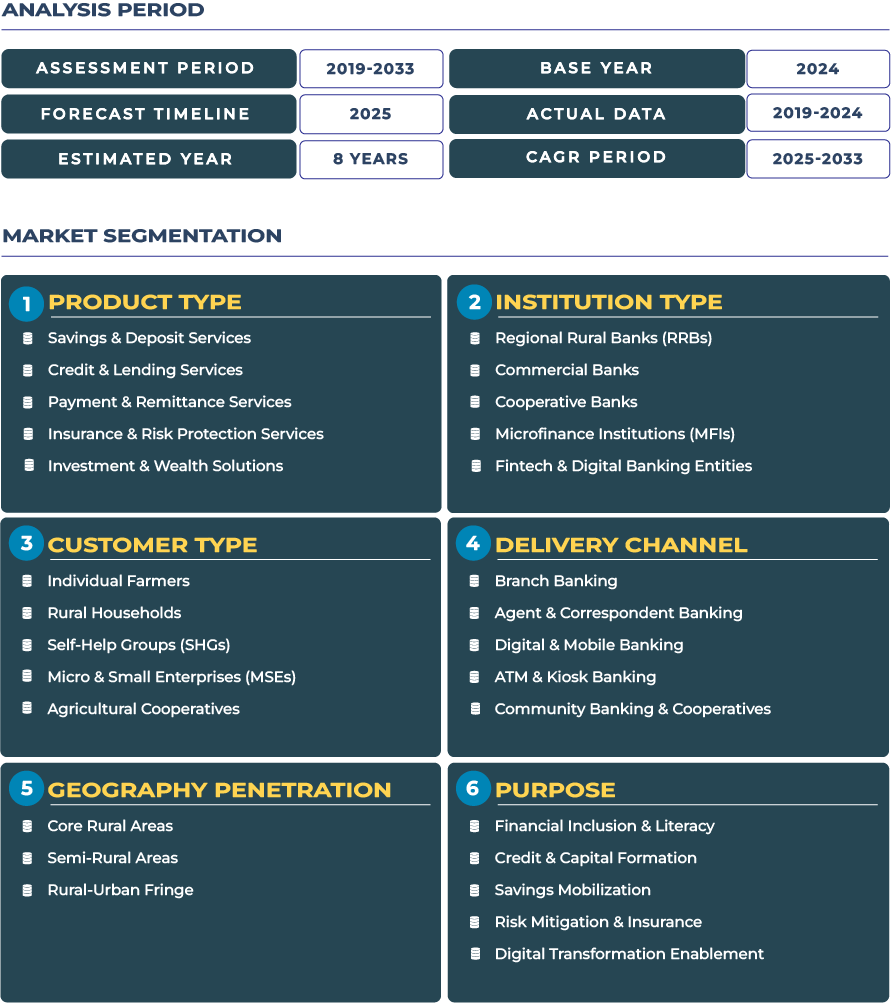Water-Efficient Agribusiness Finance: How Chile’s Rural Banks Are Cultivating Export Sustainability
Chile rural banking market is increasingly defined by its role in financing water-efficient agribusiness and export-oriented farming. In a country where droughts and glacier retreat are reshaping agricultural practices, rural banks are adapting by offering loans tied to drip-irrigation systems, efficiency upgrades and value-chain financing for grapes, berries and wine-grape export farms. The rural banking ecosystem in Chile is evolving from traditional commodity credit to specialised finance for climate-resilient farming. As of 2025, the Chile rural banking industry is estimated to be valued at approximately USD 4.4 billion, with projections to reach about USD 4.9 billion by 2033, reflecting a modest compound annual growth rate (CAGR) of around 1.4%. These figures underscore both the maturity of Chile rural banking sector and the incremental nature of its growth in the face of structural constraints.
Note:* The market size refers to the total fees/revenue generated by banks through various services.
Within the broader sector, rural banks in Chile provide tailored savings and deposit solutions for farming cooperatives, credit and leasing for irrigation and cold-chain infrastructure, payment services for migrant / export staff and remittance networks, rural insurance and risk-protection products tied to drought and export risk, and investment and wealth products aimed at rural business owners engaging in agro-exports. The mature regulatory environment and relatively high bank-penetration rates mean that growth hinges not on reaching new clients but on upgrading services and adapting to climate-agriculture demands.
Chile Rural Banking Market Outlook – Export-Driven Irrigation Finance Anchors Chile Rural Banking Growth Trajectory
The market outlook for the Chile rural banking sector signals steady but constrained growth. The trajectory reflects a banking market largely serving a defined client base of medium-sized farming enterprises, cooperatives and export-oriented value-chains rather than mass rural retail expansion. The decisive driver of growth is financing tied to efficiency upgrades, especially in irrigation, cold storage and water-management systems, which are becoming critical in Chile’s semi-arid agricultural zones.
The rural banking ecosystem in Chile benefits from stable institutions such as BancoEstado, the state-owned bank with national reach, which has expanded its presence into rural and remote communes, supporting financial inclusion and infrastructure investments in underserved regions. While the broader Chilean economy faces headwinds from global commodity cycles, climate disruptions and geopolitical pressures, the rural banking sector remains resilient, anchored by contract-farming, strong export linkages and the premium agriculture sector. For stakeholders, the opportunity lies less in volume leaps and more in service depth, upgrading lending models, embedding digital payments, and scaling export-finance mechanics for rural clients.
Driving Forces & Structural Constraints in Chile Rural Banking Sector
High Export Orientation and Cold-Chain Infrastructure Fuel Rural Banking Expansion
One significant driver of growth in the Chile rural banking landscape is the country’s strong export orientation in agricultural products, fruits, grapes, wine, berries and salmon-adjacent fed crops. Rural banks are financing upstream investment in cold-chain logistics and export receipts financing, which increases the demand for specialised credit and leasing services. The dense concentration of farms in valleys with developed infrastructure means banks can deploy risk-managed lending models. Furthermore, the presence of integrated finance and insurance bundles for drought risk and export price volatility has strengthened the credit appetite for rural borrowers.
Water Scarcity, Glacier Retreat and Buyer-Concentration Limit Sector Expansion
However, the Chile rural banking industry is constrained by structural challenges. Water scarcity and glacier retreat in key agricultural zones are increasing investment risk and raising cost-to-serve for irrigation-intensive operations. Many rural farms depend heavily on a handful of export buyers, which creates buyer-concentration risk, limiting banks’ willingness to extend generic credit. The relatively small scale of Chile’s rural population and the high penetration of established banking mean additional outreach has limited growth potential. These structural factors moderate the pace of expansion of the rural banking sector.
Emerging Trends & Strategic Opportunities in the Chile Rural Banking Landscape
Water-Efficiency Retrofit Loans and Buyer-Financing Models Rewriting Rural Credit Terms
A defining trend in the Chile rural banking ecosystem is the emergence of water-efficiency retrofit loans, where banks provide financing for drip irrigation, sensor networks and precision-water management systems with repayment linked to expected savings.
Opportunities in Drip-Irrigation Financing and Buyer-Backed Receivables for Rural Exporters
The next horizon for rural banking in Chile lies in financing for drip-irrigation retrofits and buyer-backed receivables finance. With increasing global demand for premium fruit and wine, rural exporters in Chile require access to capital for high-efficiency systems and logistical upgrades. Rural banks, especially cooperatives and regional institutions, are well positioned to provide this capital. The agricultural banking segment can strengthen by offering lease–to-own models for irrigation equipment, and invoice-discounting solutions tied to export contracts. These opportunities extend across service lines, credit, payments, insurance, savings, and present a path for incremental yet meaningful growth in the rural banking sector.
Competitive Landscape – Innovation Anchored in Efficiency Finance and Export-Credit Partnerships
The competitive dynamics within Chile rural banking market revolve around institutions that combine financial depth with climate-agribusiness embedding. BancoEstado, Chile’s public bank, is a key player expanding branchless services into rural areas and acting as a vehicle for financial inclusion and infrastructure credit.
Regional banks and cooperatives are also participating in this transformation by offering bundled services, leasing for efficiency upgrades, trade-finance extensions, and risk-protection packages for export contracts and climatic events. Such institutions are strengthening the rural banking ecosystem by creating value propositions beyond conventional credit. As competition intensifies, banks are aligning their strategies to embed financing within agribusiness workflows and export value chains, thereby locking in long-term relationships with high-performing rural clients.







